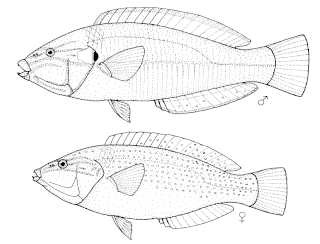
François-Louis Nompar de Caumont Laporte, comte de Castelnau was a French naturalist, known also as François Laporte or Francis de Castelnau. The standard author abbreviation Castelnau is used to indicate him when citing a botanical name and zoological names other than insects. Laporte is typically used when citing an insect name, or Laporte de Castelnau.

The Odacidae are a small family of ray-finned fishes commonly known as cales and weed whitings, formerly classified within the order Perciformes. They are related to the much larger families of the wrasses and parrotfish. More recent workers have classified this family within the order Labriformes, alongside the wrasses and parrotfishes, within the clade Percomorpha.

Anampses is a genus of wrasses native to the Indian and Pacific Oceans.

Choerodon is a genus of wrasses native to the Indian Ocean and the western Pacific Ocean. They are commonly referred to as tuskfish, because most species have sharp tusk-like teeth.

Notolabrus is a genus of wrasses native to the eastern Indian Ocean and the southwestern Pacific Ocean from Australia to New Zealand.

Pseudolabrus is a genus of wrasses native to the eastern Indian Ocean and the Pacific Ocean.

Suezichthys is a genus of wrasses native to the southeastern Atlantic Ocean through the Indian Ocean to the Pacific Ocean.

Thalassoma is a genus of wrasses native to the Atlantic, Indian and Pacific Oceans. Many species occasionally make their way into the aquarium trade.

Xyrichtys is a genus of wrasses native to the Atlantic, Indian and Pacific Oceans, where they are found in sandy-bottomed habitats. They are commonly known as razorfishes, as they are very laterally compressed with a sharp bony ridge at the front of their heads. This adaptation allows them to burrow very quickly into the sand at any sign of danger.

Halichoeres are a genus of wrasses found in the Atlantic, Indian and Pacific Oceans.

The bluestreak cleaner wrasse, Labroides dimidiatus, is one of several species of cleaner wrasses found on coral reefs from Eastern Africa and the Red Sea to French Polynesia. Like other cleaner wrasses, it eats parasites and dead tissue off larger fishes' skin in a mutualistic relationship that provides food and protection for the wrasse, and considerable health benefits for the other fishes.

Pseudocheilinus is a genus of wrasses native to the Indian and Pacific Oceans.

Labrus is a genus of wrasses native to the eastern Atlantic Ocean into the Mediterranean and Black seas.

Labroides is a genus of wrasses native to the Indian and Pacific Oceans. This genus is collectively known as cleaner wrasses, and its species are cleaner fish.

Stegastes leucostictus is a species of damselfish found near the sea bed in shallow waters on the western fringes of the Atlantic Ocean. It is commonly known as the beau gregory or beaugregory.

Clepticus is a genus of wrasses native to the Atlantic Ocean.

Decodon is a genus of wrasses found in the western Atlantic Ocean, the western Indian Ocean and the Pacific Ocean.

Epibulus is a genus of wrasses native to the Indian Ocean and the western Pacific Ocean.

Stethojulis is a genus of wrasses native to the Indian and Pacific Oceans.

Dotalabrus aurantiacus, Castelnau's wrasse, is a species of wrasses native to the Indian Ocean coasts of Australia. It is the type species of its genus. The type locality is Adelaide, St. Vincent Gulf, South Australia.




















